Winter biking 101: How to cycle through sleet and snow
Many people retire their wheels at the first sign of snow. But for what? Here’s a beginner’s guide to biking in winter with tips, tricks and gear suggestions to get you started.
So you’re thinking about winter biking, but you’re worried you’re not hardcore enough. Let me ask you this, what method of getting around in the winter isn’t hardcore in its own right? Living in a cold climate requires a certain degree of fortitude, and deciding to leave your house between November and March, even more so. Does it really even matter how many wheels you have under you once you’ve thrown on those 18 layers of clothing and walked out the front door?
I would argue that driving in the winter is infinitely more terrifying than riding around on a bike, and you also have to deal with shovelling your car out, scraping the windows, and occasionally having the car just not start at all because you decided to settle in Winnipeg. There’s the bus, which requires standing out in the whipping, frostbitten wind waiting 15 minutes for a bus which always runs behind schedule because of all the snow, only for it to arrive and to have to crowd in to its wet, slushy interior packed full of sniffling, sneezing, de-frosting people. If that doesn’t sound like your cup of tea, you could take the subway, and do that thing where you get dressed for -33 (-30 C) but then you go into the underground which, on account of all the machinery, remains about 104 degrees (40 C) all winter long so you shock your body into a profuse sweat every single morning and evening. None of these options are relaxing. Walking is admittedly pretty nice, but it’s slow. And occasionally you slip on some ice and throw your chai latte up into the air. So why not try riding your bike?

Cargo Bikes, Locks, E-Bikes, & How-To's
Check out any one of our guides made to inspire the urban cyclist in you. Discover today.
This isn’t to suggest that winter biking is perfect, but that all the modes are themselves equally flawed. Yet for some reason winter biking is the one mode cast as the domain of only the particularly hardcore. As if there’s nothing hardcore about spending 30 minutes on a packed, slush-bucket of a subway car every morning while you try not to sweat too much knowing it’s only going to freeze when you go back outside. I certainly don’t have the nerve for that.
Most importantly, winter biking is beautiful. Imperfect maybe, but it is quiet and calming, and it’s a way to fall in love with biking all over again as you experience it in a new season. Sure, it takes a little extra preparation and a little extra gear, but the gratification that comes with the ride is well worth it.
So we’ve put together a few tips and tricks to make sure you have the safest and most enjoyable winter biking experience possible. These are all are tips and gear suggestions for winters of the below-freezing and snowy variety. While there is a considerable amount of crossover, if yours is more of a wetter winter, check out our guide to biking in the rain for suggestions for on how to stay safe, dry, and comfortable in wet climates.
How to Bike in the Winter
Start slowly.
There’s no need to sell your car and cancel your bus pass before your first ride. Take a few short trips on your days off to get a feel for it and make sure you enjoy it before you commit to a full-on winter commuting schedule.
Plan ahead
Many cities are now beginning to plow bike lanes. Find out which bike lanes are plowed, and plan your route accordingly. If there are no bike routes, take traffic-calmed back streets where you’re most likely to have the road to yourself.
Get visible!
Falling snow, low-hanging clouds, short days, and dim light all seriously obscure vision. Get yourself a good, bright set (or three) of waterproof bike lights, and don’t leave the house without them.
Adjust your braking
Similar to when driving, you don’t want to slam on the brakes while biking on icy roads. Brake slowly to prevent spinouts, and brake more on the rear wheel. Give yourself twice the amount of time to come to a stop as you would in the summer.
Don’t strap in
One, you really needn’t be going too quickly anyway, but in case you fishtail or start to fall, you’ll want to have your feet free to get them to the ground.
Ride defensively
Even in areas where there are high rates of summertime cycling, most people don’t expect bikes on the roads in the winter, so they often aren’t looking out for you. Give motorists extra space, stay out of blind spots, and make eye contact with drivers whenever possible.
Learn to recognize ice
Black ice forms where snow melts in the sunlight then re-freezes once the sun goes down. Ride carefully in areas which get direct sunlight all day, or anywhere that appears wet on a below-freezing day.
Take the lane
Snow and debris accumulate along the curb, basically taking over the line which most people usually bike in. Ride in the middle of the lane. It will also make you more visible and ensure nobody can pass you without changing lanes.
Maintain your bike
Wipe your bike down every day to avoid rust. Clean and lubricate the chain and gears once a week if you’re riding a bike with a derailleur, and clean and lubricate the brake lines every few weeks. Read our guide on how to maintain your bicycle through winter for a more in-depth look at what you should be doing and why.
Expect to fall
You probably will. Ride slowly and anticipate a slip or two.
Be reasonable
Combine winter-biking with public transit if you have a crazy long trip or you get cold and tired halfway through – nobody says you have to bike the whole way. And as we said, winter biking isn’t about being hardcore. You do it because you love it, not because you have to prove something.
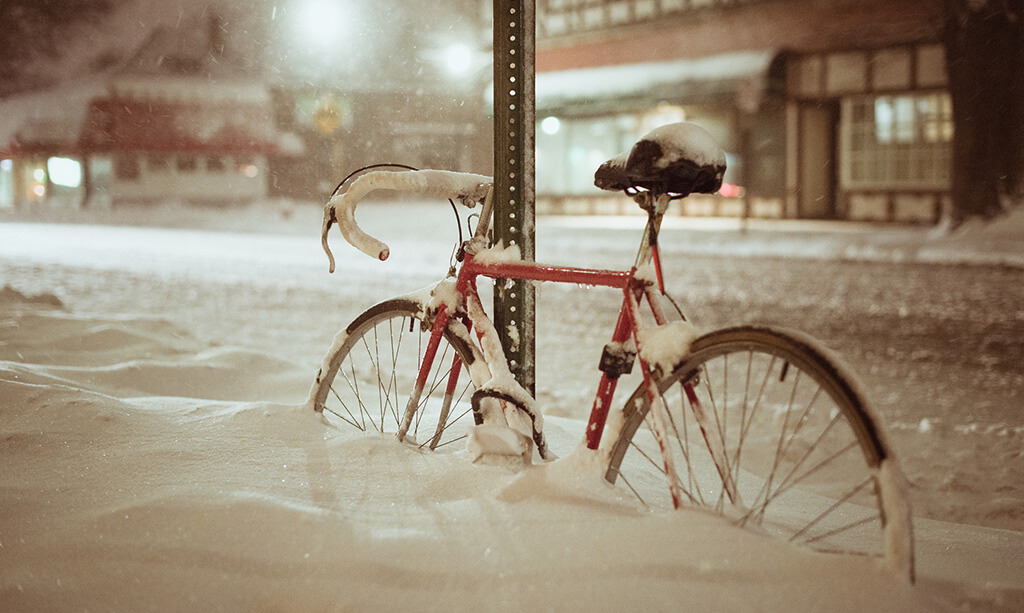
A good reason to invest in a winter bike. Photo by chuddlesworth
If it’s a white-out day and you can’t see your neighbour’s house, you can be sure no motorist is going to see you pedaling along either – you may want to leave the bike at home. Or better yet, leave yourself at home, build a quinzee, and crack out the rum and eggnog. Tis the season!
More from Momentum Mag
13 Comments
Autumn Gear Guide
Find inspiration in our Gear Guide that will keep you out on your bike through wind or rain.
Download Now
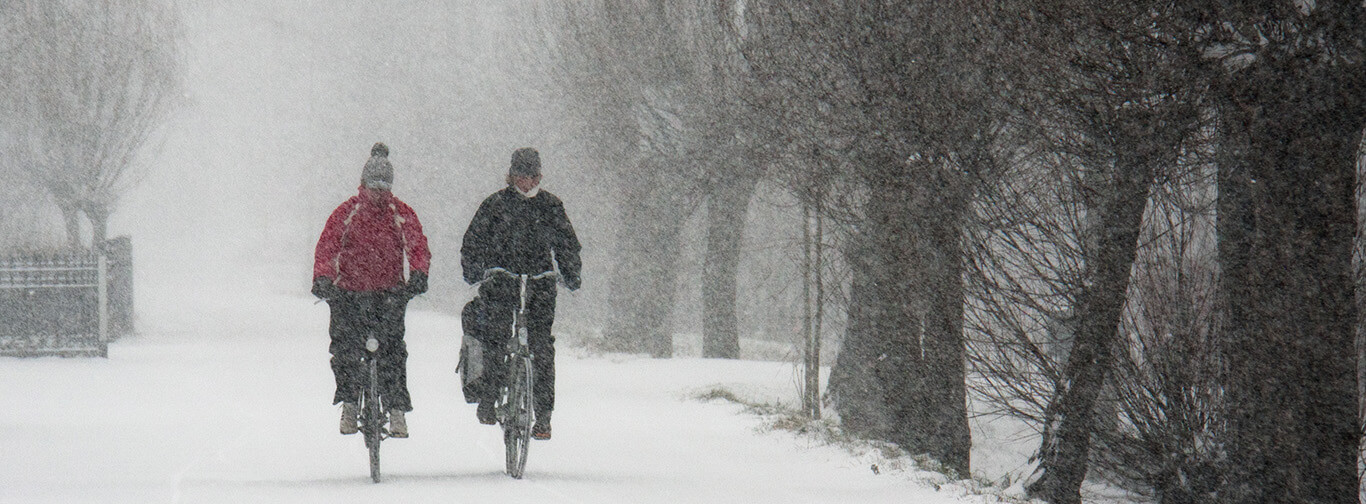
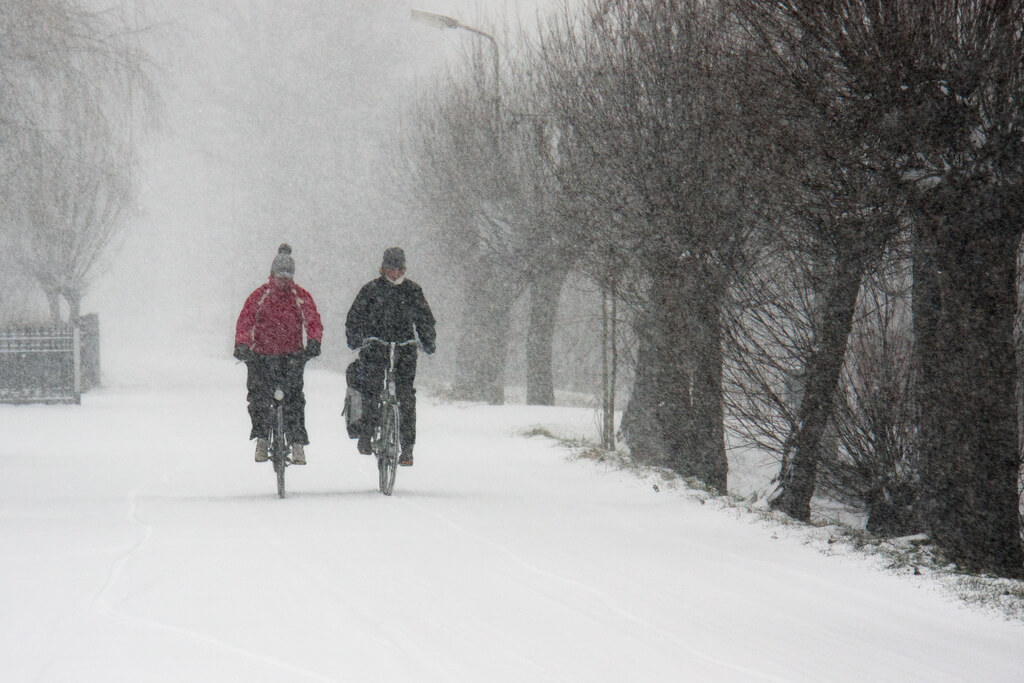
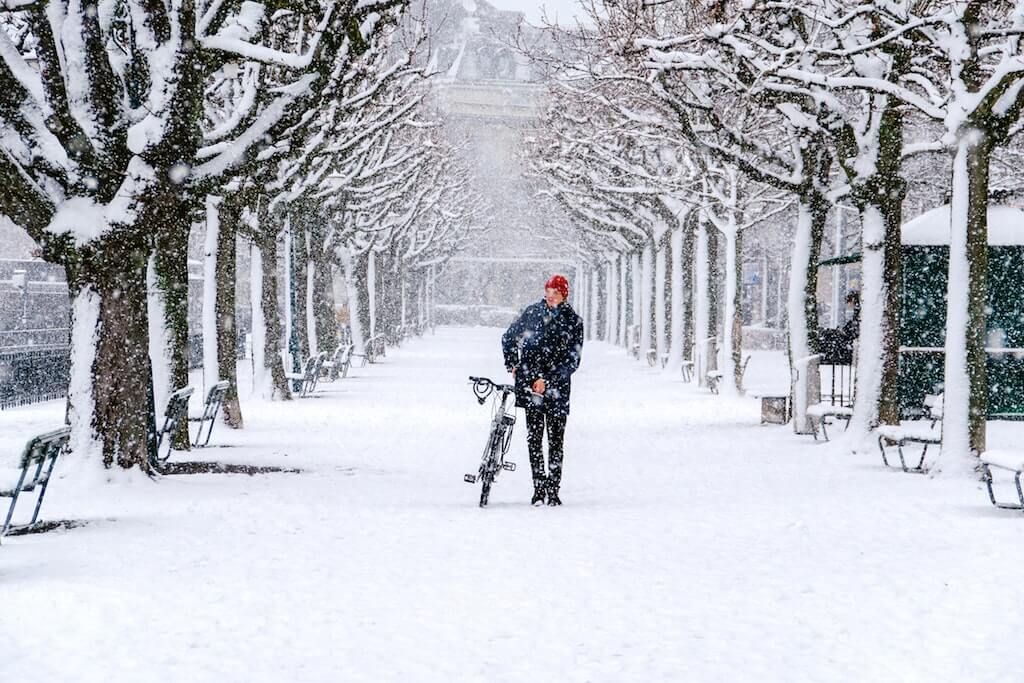
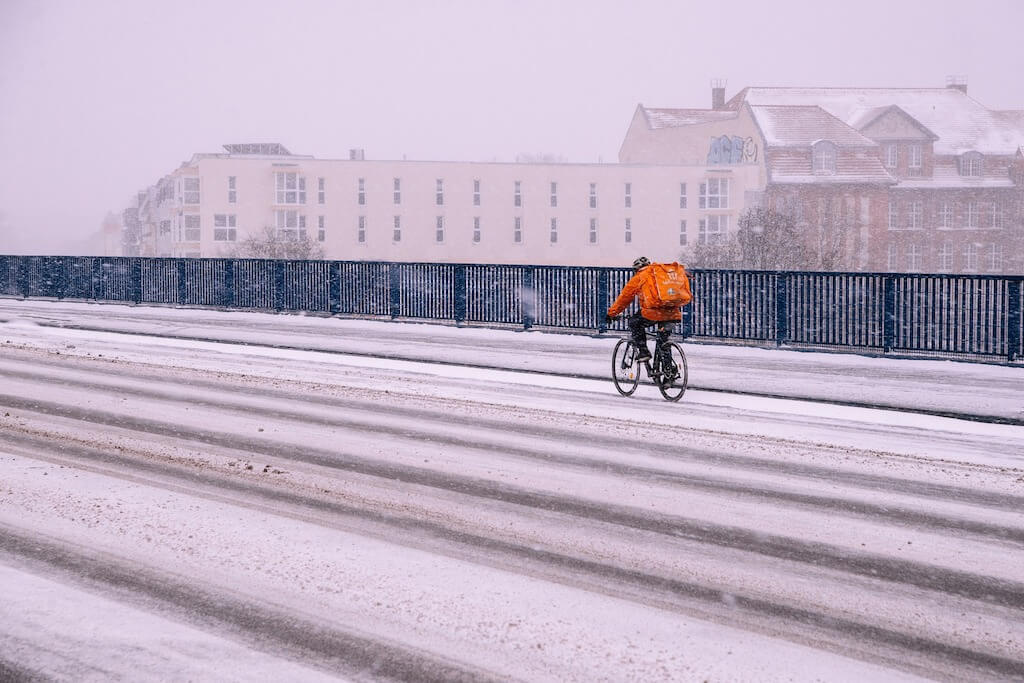
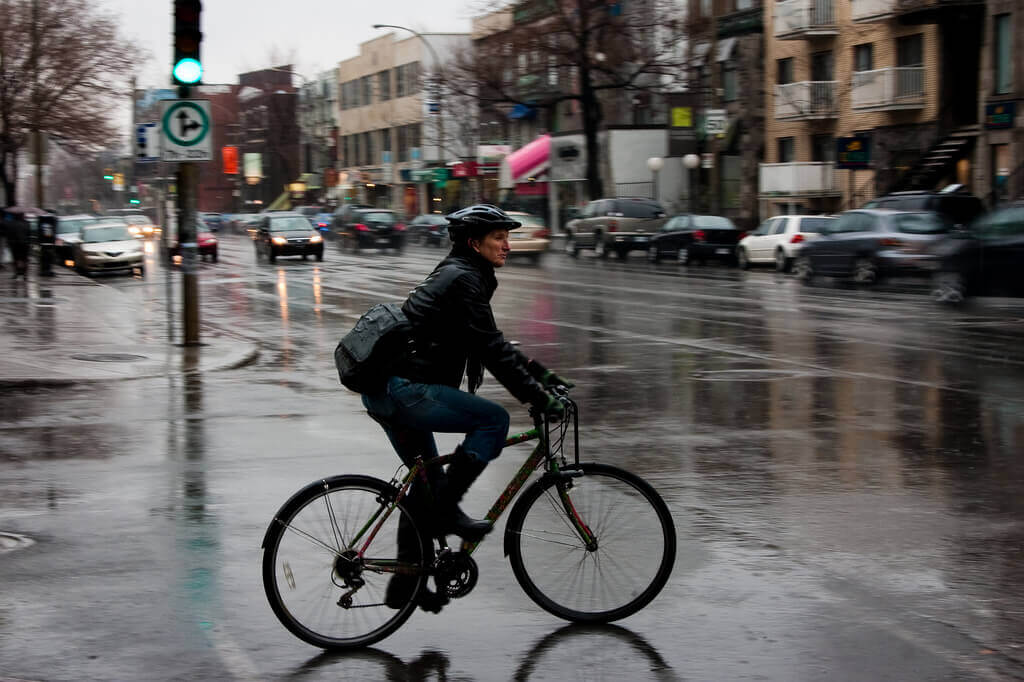
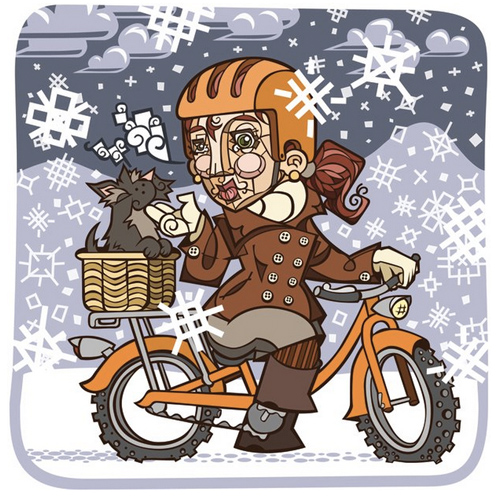
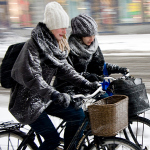
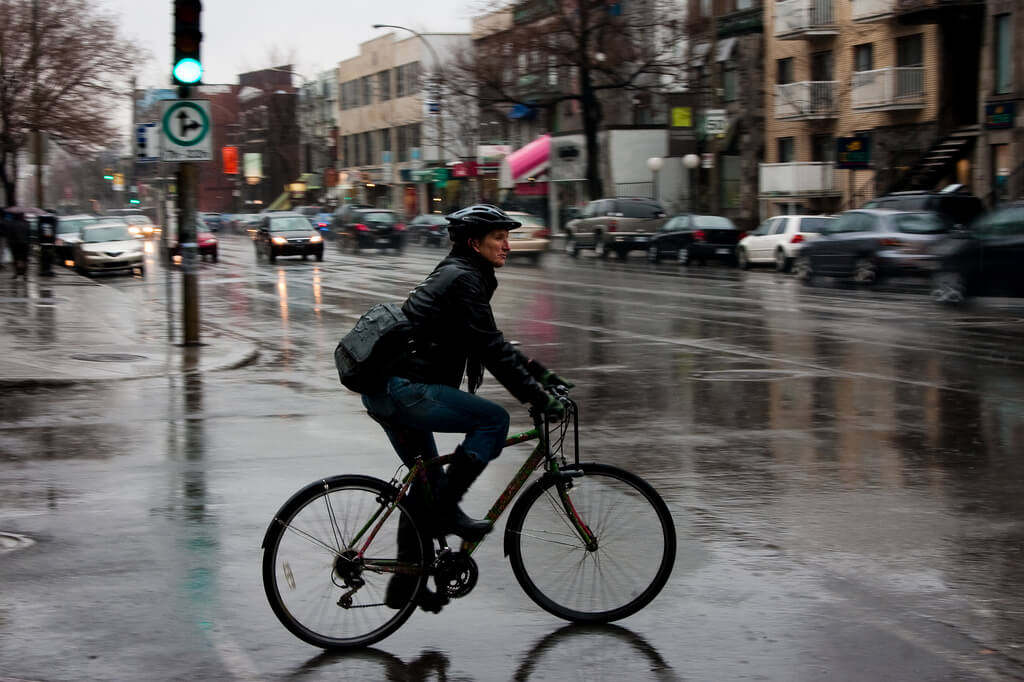
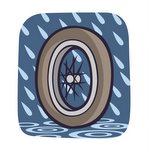

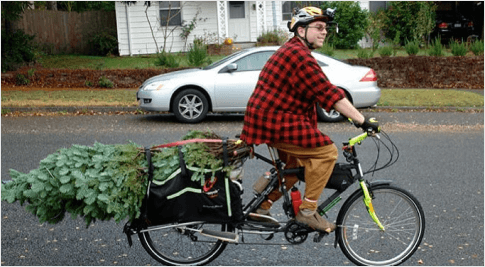
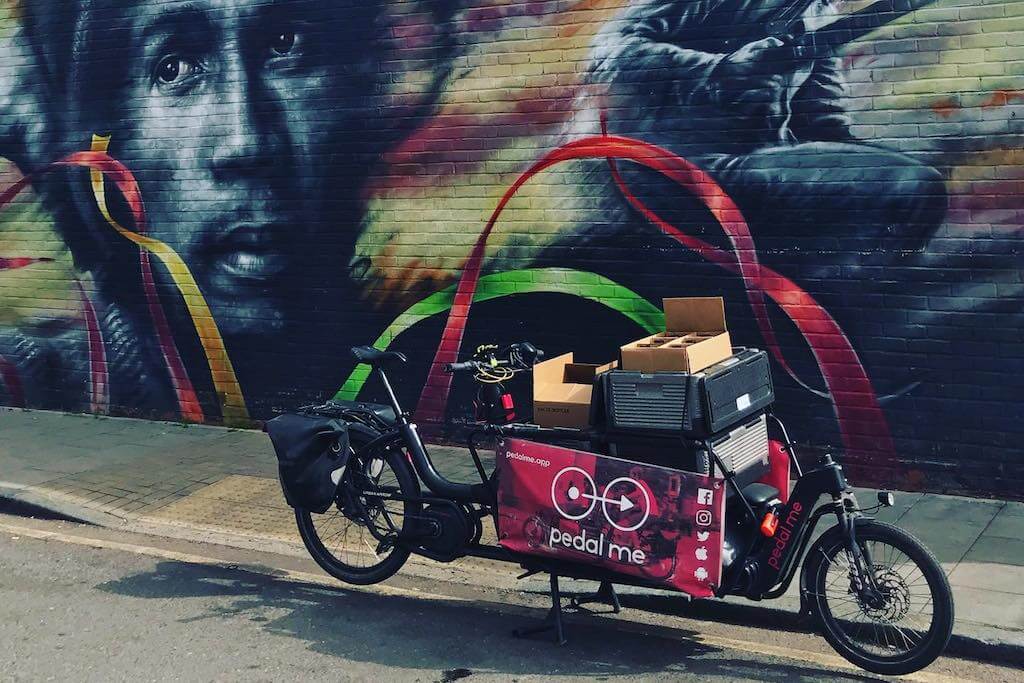

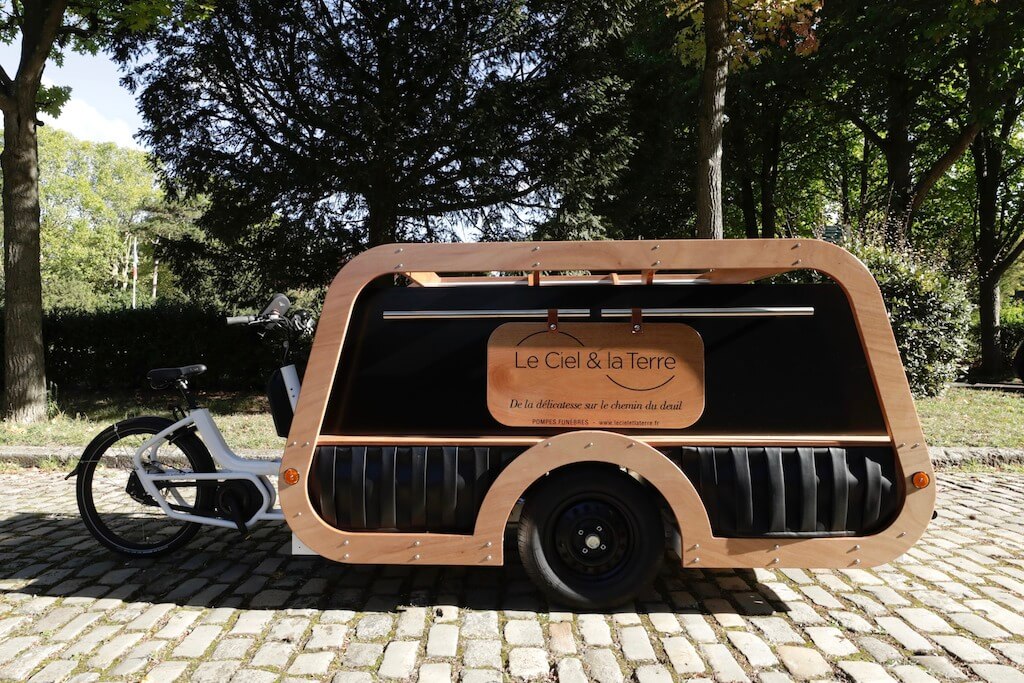
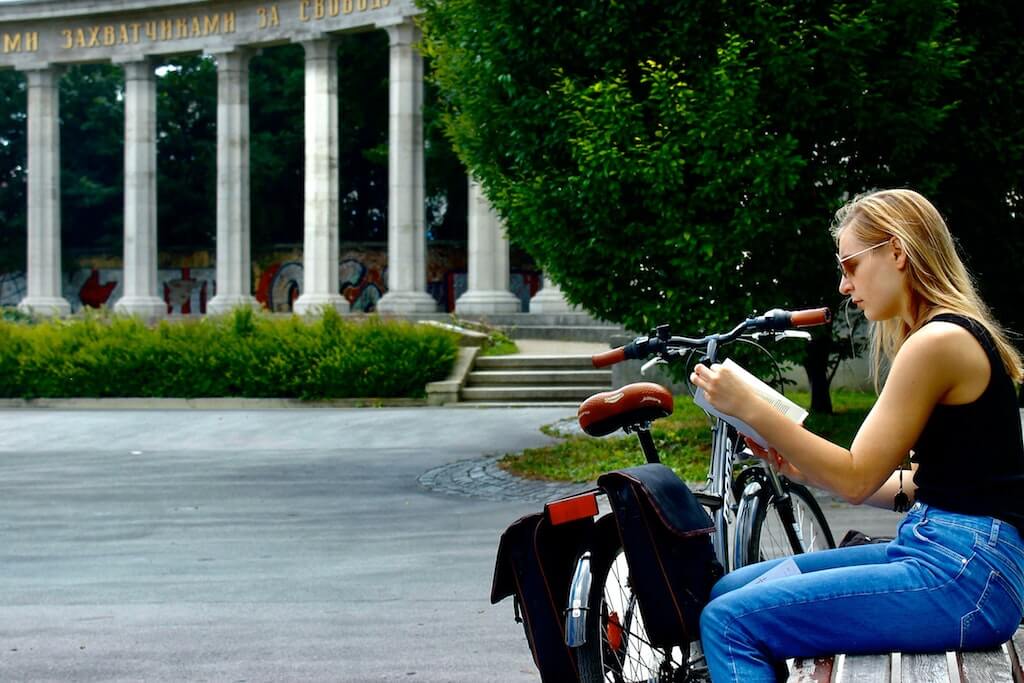

Good write up. And the clothing recommendations are good, but if folks think they have to buy a lot of expensive gear they may not take up winter riding. I’m big fan of thrift stores where you can find lots of wool sweaters, nylon windbreakers, insulated jackets and vests, and nylon cover pants all at a cheap price. And a lot of people have ski gear that will work pretty well. Snow packs/Sorel boots work great with platform pedals. Just get out and ride. Buy kit as you need it.
Hi from Germany. I bike commute all year. True we don’t get blizzards but if it doesn’t get colder than -10C (around 15F) all you need is two briefs and two woolen sweaters under your jacket, and a bit of old newspaper in your boots (fold the old newspaper, stand on it, outline your feet with a felt marker, and cut the shapes out, put that in your boots or shoes. Wonderfully warm). Not everyone wants or needs to invest in a lot of kit. The other suggestion I have is change your tyres to CX tyres or 28″ tyres with a knobby tread (I run Schwalbe Smart Sams in 40-622 in the snow, they’re all I need and they are cheap). The one type of kit I really suggest is an unlined reflective jacket such as runners use. It will normally be dark when you ride to or from work so having a lot of reflective surface on your body is a great improvement in your safety. These jackets are also cheap (I got mine at around 30USD on amazon). Buy them one size up so you can wear your favourite puffer jacket under it. And for your head, I suggest you ride with a full face (downhill) helmet. It keeps you warm enough without a balaclava, remember that your head will be covered in styrofoam. If you do slip, you’re also safer. Add a thick scarf knitted by mum or grandma and you’re all set! Happy cycling and stay safe.
For me studded tires were one of the first pieces of equipment I purchased to bike through New England winter. Otherwise, clothing is pretty easy – a heavy wool jacket with wool sweater layering underneath, a Buff face/neck warmer, wool lined boots and down ski mittens are all I need. I also use a helmet with a winter liner that also doubles as a ski helmet. I much prefer winter biking to riding public transit or driving. I love the quiet and solitude but would not mind a little more company.
Great write-up! I found $20 heavy duty snowmobiling gloves from Costco work great. Long cuff and flexible enough for shifting and braking. And affordable! My tips are here: https://ridecyclespin.com/2016/10/28/winter-is-coming/
This is my fifth year riding through the New England winter. Road crews here in Maine do a good job clearing snow. But we get hard pack and ice, especially on the bike-only trails, so studded tires are almost a necessity. I say ‘almost’ because I do see some other cyclists getting along on just rubber. But when I splurged for the studs a few years ago my cycling life changed forever. I’d never go back. Deep snow and slush are still a problem — just like riding a mountain bike in deep mud, but I actually feel very stable on glare ice with the studs. Riding on ice is more fun than pavement, especially on a steep incline when I can amaze the slipping pedestrians.
I’ve found that winter cycling is really hard on the bike. It’s easy to say that you should do weekly cleaning and maintenance, but much harder to do in the real world of cold winter weather. I can wipe off some of the grit with a rag and squirt some lubricant on the chain, but that’s about it. Every April I find myself replacing at least something in my drivetrain — a chainwheel, cogs or even a whole cassette. The derailleurs have lasted pretty well. However, a new chain is a given every spring.
I wear mittens. Shifting gears and braking with even thick mittens aren’t a problem for me maybe because I’m always going so slow I have lots of reaction time. I wear long johns and layers all winter anyway, starting about mid-November, so it’s not like I get kitted out in some special cycling outfit. My winter cycling is mostly what I’d call utility cycling — errands, commuting, going to the library — so I want to be dressed sort of normally when I get off the bike. But warm.
I love cycling and simply can’t give it up for even a few months. Indoor riding is too boring for words, so I bundle up and hit the road. Every year I find myself looking forward to riding in the snow and ice.
I live in Montana and its pretty cold lately. About 0 degrees F. Goggles are a must. I’m used to them though because I ride downhill with them in the summer so the lack of peripheral vision is ok. I really want some bar mitts but have just been trying to eek through this really cold spell with mittens. They just don’t offer enough dexterity though, especially for braking on the fly. I find to lure new winter riders we need to maintain (snow removal) our roads better and make routes to schools and work a priority in at least two n-s and e-w directions in our town.
When it is below zero I wear a snowmobile suit and snowmobile boots and take my time. Bar mitts are a must have as are wide studded tires. It can get very icy here in southern Wisconsin.
Bar Mitts, they’re a game changer! Neoprene pockets that fit over your handlebars that trap in the heat. I still wear my “summertime” fingerless gloves with them and have ample agility with my gear shifting and braking.
Admittedly tend to winter cycle when the pavement is dry. I haven’t yet invested in studded tires. Calgary does do a reasonable job of snow-clearing the park pathway system, at least the major pathway arteries. You would be amazed to see what is done for its first separated bike lane on 7th St. for snowclearing. We can hear snowclearing machines…@night.
I cycle down to -24 degrees C (and if pavement is dry) for short cycle commutes. Purely functional ride. It’s tough to take off my cycling lobster claw gloves in order to lock up my bike outdoors. But gotta do it. That’s when I realize my fingers can only tolerate certain winter cold.
But most definitely even a small amount of winter cycling can keep you minimally fit for other activities outdoors. Not kiddin’. I’m grateful when snowshoeing in the mountains to have abit of cycling fitness.
I’ve been riding all winter for over 10 years now, and here’s what I have found works well:
Wool. Nothing is better in the winter. There are several brands of wool clothing that work well. I look for garments that are at least 50% merino. They don’t have to be cycling specific since in the winter you are not going to be using the rear pockets anyway.
Shearling wool mittens. Yes, you can operate a bicycle just fine with mittens, and they are warmer than gloves. Shearling works much, much better than any synthetic; it’s warmer, it breathes, and it doesn’t stink if your hands sweat. I get them XL so I can wear a liner glove on really cold (< -12C) days. Shearling wool mittens are kinda hard to find, but are totally worth it.
Fat tires. The fatter the better. The problem with winter riding is not riding on smooth ice or packed snow, it's riding on rutted ice or slushy snow. If you get your front wheel caught it a rut, or if it starts sliding sideways in slushy snow, you're probably going down. The fat tires roll over the ruts and slush. My winter bike is now a fat bike with 4" tires and it works so much better than my city bike with 35mm (1.4") tires. Forget the studded tires, they don't help in the ruts and slush. Fat is where it's at.
Comments are closed.